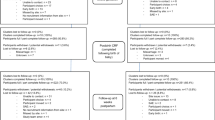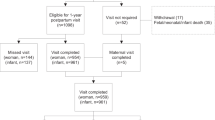Abstract
Objective
To assess the cost-effectiveness of a mobile health-supported lifestyle intervention compared with usual care.
Methods
We conducted a cost-effectiveness analysis from the perspective of the publicly-funded health care system. We estimated costs associated with the intervention and health care utilisation from first antenatal care appointment through delivery. We used bootstrap methods to quantify the uncertainty around cost‐effectiveness estimates. Health outcomes assessed in this analysis were gestational weight gain (GWG; kg), incidence of excessive GWG, quality-adjusted life years (QALYs), and incidence of large-for-gestational-age (LGA). Incremental cost-effectiveness ratios (ICERs) were calculated as cost per QALY gained, cost per kg of GWG avoided, cost per case of excessive GWG averted, and cost per case of LGA averted.
Results
Total mean cost including intervention and health care utilisation was €3745 in the intervention group and €3471 in the control group (mean difference €274, P = 0.08). The ICER was €2914 per QALY gained. Assuming a ceiling ratio of €45,000, the probability that the intervention was cost‐effective based on QALYs was 79%. Cost per kg of GWG avoided was €209. The cost-effectiveness acceptability curve (CEAC) for kg of GWG avoided reached a confidence level of 95% at €905, indicating that if one is willing to pay a maximum of an additional €905 per kg of GWG avoided, there is a 95% probability that the intervention is cost-effective. Costs per case of excessive GWG averted and case of LGA averted were €2117 and €5911, respectively. The CEAC for case of excessive GWG averted and for case of LGA averted reached a confidence level of 95% at €7090 and €25,737, respectively.
Conclusions
Results suggest that a mobile-health lifestyle intervention could be cost-effective; however, a better understanding of the short- and long-term costs of LGA and excessive GWG is necessary to confirm the results.
This is a preview of subscription content, access via your institution
Access options
Subscribe to this journal
Receive 12 print issues and online access
$259.00 per year
only $21.58 per issue
Buy this article
- Purchase on Springer Link
- Instant access to full article PDF
Prices may be subject to local taxes which are calculated during checkout



Similar content being viewed by others
References
Motee A, Jeewon R. Importance of exclusive breastfeeding and complementary feeding among infants. Curr Res Nutr Food Sci. 2014;2:17.
Walsh JM, McGowan CA, Mahony RM, Foley ME, McAuliffe FM. Obstetric and metabolic implications of excessive gestational weight gain in pregnancy. Obesity. 2014;22:1594–1600.
Chu SY, Callaghan WM, Bish CL, D’Angelo D. Gestational weight gain by body mass index among US women delivering live births, 2004-2005: fueling future obesity. Am J Obstet Gynecol. 2009;200:271.e271–271.e277.
Mamun A, Mannan M. Gestational weight gain in relation to offspring obesity over the life course: a systematic review and bias‐adjusted meta‐analysis. Obes Rev. 2014;15:338–47.
Schack-Nielsen L, Michaelsen KF, Gamborg M, Mortensen EL, Sørensen TI. Gestational weight gain in relation to offspring body mass index and obesity from infancy through adulthood. Int J Obes. 2010;34:67.
Amorim AR, Rössner S, Neovius M, Lourenço PM, Linné Y. Does excess pregnancy weight gain constitute a major risk for increasing long‐term BMI? Obesity. 2007;15:1278–86.
Withrow D, Alter DA. The economic burden of obesity worldwide: a systematic review of the direct costs of obesity. Obes Rev. 2011;12:131–41.
Morgan KL, Rahman MA, Hill RA, Khanom A, Lyons RA, Brophy ST. Obesity in pregnancy: infant health service utilisation and costs on the NHS. BMJ Open. 2015;5:1.
Kuhle S, Muir A, Woolcott CG, Brown MM, McDonald SD, Abdolell M, et al. Maternal pre-pregnancy obesity and health care utilization and costs in the offspring. Int J Obes. 2019;43:735–43.
Bain E, Crane M, Tieu J, Han S, Crowther CA, Middleton P. Diet and exercise interventions for preventing gestational diabetes mellitus. Cochrane Database Syst Rev. 2015;1:CD010443. https://doi.org/10.1002/14651858.CD010443.pub2.
Tieu J, Shepherd E, Middleton P, Crowther CA. Dietary advice interventions in pregnancy for preventing gestational diabetes mellitus. Cochrane Database Syst Rev. 2017;1:1.
Kennelly MA, Ainscough K, Lindsay K, Gibney E, Mc Carthy M, McAuliffe FM. Pregnancy, exercise and nutrition research study with smart phone app support (Pears): study protocol of a randomized controlled trial. Contemp Clin Trials. 2016;46:92–9.
Kennelly MA, Ainscough K, Lindsay KL, O’Sullivan E, Gibney ER, McCarthy M, et al. Pregnancy exercise and nutrition with smartphone application support: a randomized controlled trial. Obstet Gynecol. 2018;131:818–26.
National Research Council. Weight gain during pregnancy: reexamining the guidelines. National Academies Press, Birmingham, UK, 2010.
Gardosi J, Francis A. Customised weight centile calculator. GROW version 6.7.8.5(IE). Gestation Network, Birmingham, UK, 2016.
Health Service Executive. April 2017 revised consolidated payscales. In Edited by Health Service Executive; 2017.
Health Information and Quality Authority. Guidelines for the economic evaluation of health technologies in Ireland. Dublin: HIQA; 2014.
National Casemix Pogramme of the Health Services Executive. Ready reckoner of acute hospital inpatient and daycase activity & costs (summarised by DRG) relating to 2011 costs and activity. In. Edited by Programme NC; 2013.
Health Service Executive. Activity-based funding programme: Implementation Plan 2015–2017. Ireland, Health Service Executive, 2015. https://assets.gov.ie/40185/74ffe4e1dc104cd6856b5a32375d8d5f.pdf. Accessed 15 Jan 2020.
Dadouch R, Faheim M, Juando-Prats C, Parsons J, D’Souza R.COSSOPP Investigators Development of a Core Outcome Set for Studies on Obesity in Pregnant Patients (COSSOPP): a study protocol. Trials. 2018;19:655
Hammitt JK. Optimal gestational weight gain: risk tradeoff calculations. Appendix G, Part IV, 674-683 in Institute of Medicine Committee on Reexamination of Pregnancy Weight Guidelines, Weight gain during pregnancy: reexamining the guidelines. Washington, D.C.: National Academies Press; 2009.
O’Mahony JF, Coughlan D. The Irish cost-effectiveness threshold: does it support rational rationing or might it lead to unintended harm to Ireland’s health system? PharmacoEconomics. 2016;34:5–11.
National Institute for Health and Care Excellence. Developing NICE guidelines: the manual. London, UK: National Institute for Health and Care Excellence; 2018.
Heery E, Kelleher CC, Wall PG, McAuliffe FM. Prediction of gestational weight gain—a biopsychosocial model. Public Health Nutr. 2015;18:1488–98.
Haugen M, Brantsæter AL, Winkvist A, Lissner L, Alexander J, Oftedal B, et al. Associations of pre-pregnancy body mass index and gestational weight gain with pregnancy outcome and postpartum weight retention: a prospective observational cohort study. BMC Pregnancy Childbirth. 2014;14:201.
Nehring I, Schmoll S, Beyerlein A, Hauner H, von Kries R. Gestational weight gain and long-term postpartum weight retention: a meta-analysis. Am J Clin Nutr. 2011;94:1225–31.
Rooney BL, Schauberger CW, Mathiason MA. Impact of perinatal weight change on long-term obesity and obesity-related illnesses. Obstet Gynecol. 2005;106:1349–56.
Ferraro Z, Barrowman N, Prud’Homme D, Walker M, Wen S, Rodger M, et al. Excessive gestational weight gain predicts large for gestational age neonates independent of maternal body mass index. J Matern-Fetal Neonatal Med. 2012;25:538–42.
Yu Z, Han S, Zhu G, Zhu C, Wang X, Cao X, et al. Birth weight and subsequent risk of obesity: a systematic review and meta‐analysis. Obes Rev. 2011;12:525–42.
Harder T, Roepke K, Diller N, Stechling Y, Dudenhausen JW, Plagemann A. Birth weight, early weight gain, and subsequent risk of type 1 diabetes: systematic review and meta-analysis. Am J Epidemiol. 2009;169:1428–36.
Harder T, Rodekamp E, Schellong K, Dudenhausen JW, Plagemann A. Birth weight and subsequent risk of type 2 diabetes: a meta-analysis. Am J Epidemiol. 2007;165:849–57.
Dee A, Kearns K, O’Neill C, Sharp L, Staines A, O’Dwyer V, et al. The direct and indirect costs of both overweight and obesity: a systematic review. BMC Res Notes. 2014;7:242.
Zhuo X, Zhang P, Hoerger TJ. Lifetime direct medical costs of treating type 2 diabetes and diabetic complications. Am J Prev Med. 2013;45:253–61.
Han S, Middleton P, Crowther CA. Exercise for pregnant women for preventing gestational diabetes mellitus. Cochrane Database Syst Rev. 2012;1:CD009021. https://doi.org/10.1002/14651858.CD009021.pub2.
Kolu P, Raitanen J, Rissanen P, Luoto R. Cost-effectiveness of lifestyle counselling as primary prevention of gestational diabetes mellitus: findings from a cluster-randomised trial. PLoS ONE. 2013;8:1–12.
Dodd JM, Ahmed S, Karnon J, Umberger W, Deussen AR, Tran T, et al. The cost-effectiveness of providing antenatal lifestyle advice for women who are overweight or obese: the LIMIT randomised trial. BMC Obes. 2015;2:14.
Oostdam N, Bosmans J, Wouters MG, Eekhoff EM, van Mechelen W, van Poppel MN. Cost-effectiveness of an exercise program during pregnancy to prevent gestational diabetes: results of an economic evaluation alongside a randomised controlled trial. BMC Pregnancy Childbirth. 2012;12:64.
Willcox J, Wilkinson S, Lappas M, Ball K, Crawford D, McCarthy E, et al. A mobile health intervention promoting healthy gestational weight gain for women entering pregnancy at a high body mass index: the txt4 two pilot randomised controlled trial. BJOG: Int J Obstet Gynaecol. 2017;124:1718–28.
Stephenson J, Patel D, Barrett G, Howden B, Copas A, Ojukwu O, et al. How do women prepare for pregnancy? Preconception experiences of women attending antenatal services and views of health professionals. PLoS ONE. 2014;9:e103085.
Dodd JM, Deussen AR, Louise J. Optimising gestational weight gain and improving maternal and infant health outcomes through antenatal dietary, lifestyle and physical activity advice: the OPTIMISE randomised controlled trial protocol. BMJ Open. 2018;8:e019583.
Kolu P, Raitanen J, Puhkala J, Tuominen P, Husu P, Luoto R. Effectiveness and cost-effectiveness of a cluster-randomized prenatal lifestyle counseling trial: a seven-year follow-up. PloS ONE. 2016;11:e0167759.
O’Brien OA, Lindsay KL, McCarthy M, McGloin AF, Kennelly M, Scully HA, et al. Influences on the food choices and physical activity behaviours of overweight and obese pregnant women: a qualitative study. Midwifery. 2017;47:28–35.
Funding
The PEARs trial received funding from The National Maternity Hospital Medical Fund (Dublin, Ireland) and University College Dublin (Ireland), the authors received no additional funding to conduct the present analysis.
Author information
Authors and Affiliations
Contributions
EJOS and SR were involved in the conception, planning, carrying out, interpreting and writing up of the work. SR conducted cost-effectiveness analyses. MK and KA were involved in the conception and writing up of the work. FMcA oversaw all aspects of the work and is responsible for the final content.
Corresponding author
Ethics declarations
Conflict of interest
The authors declare that they have no conflict of interest.
Additional information
Publisher’s note Springer Nature remains neutral with regard to jurisdictional claims in published maps and institutional affiliations.
Supplementary information
Rights and permissions
About this article
Cite this article
O’Sullivan, E.J., Rokicki, S., Kennelly, M. et al. Cost-effectiveness of a mobile health-supported lifestyle intervention for pregnant women with an elevated body mass index. Int J Obes 44, 999–1010 (2020). https://doi.org/10.1038/s41366-020-0531-9
Received:
Revised:
Accepted:
Published:
Issue Date:
DOI: https://doi.org/10.1038/s41366-020-0531-9
This article is cited by
-
A cost-effectiveness evaluation of a dietitian-delivered telephone coaching program during pregnancy for preventing gestational diabetes mellitus
Cost Effectiveness and Resource Allocation (2024)
-
An explainable machine learning-based clinical decision support system for prediction of gestational diabetes mellitus
Scientific Reports (2022)



